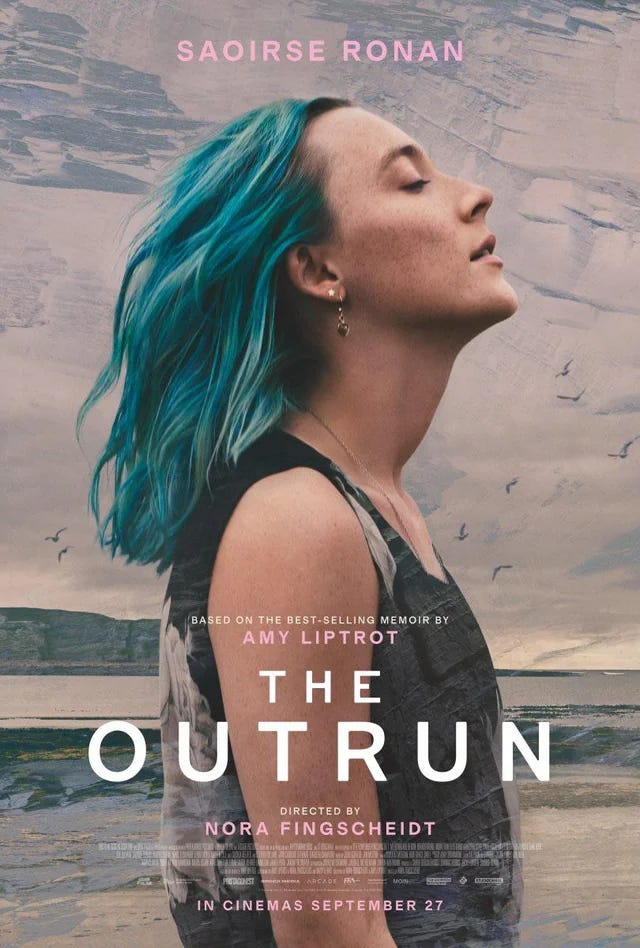In this film adaptation of Amy Liptrot’s 2015 book The Outrun, Saoirse Ronan portrays the fictional character Rona, a marine biologist deep in the throes of alcoholism. We learn about the consequences of her lying and destructive powers through the people around her, and herself. She hides bottles of vodka in the bathroom and gets emotional and aggressive on nights out. On one occasion she physically hurts her boyfriend, Daynin (Paapa Essiedu), and on another, she puts her life at risk by entering a stranger’s car after a night out.
A Tale of Two Towns
The film does a fantastic job of alternating between two locations and different periods of Rona’s life to explain the root causes of her addiction and journey to sobriety. In London, we see her hit rock bottom after the negative experiences she has in bars and the events she attends. This eventually takes its physical toll and is visibly evident on Rona’s face, which subsequently leads her to check into an AA program.
When she returns home to the Orkney Islands, we see flashbacks to her childhood that explain her parents’ divorce and the trauma she experienced watching her father have bipolar episodes. We also see the strained relationship with her mother. This rawness contrasts with their improved relationship in the film.
On the islands, she worked on her father’s farm and as a conservationist. It’s also here that we see Rona trying to make connections with the locals to build herself back up, and the relapse she suffers after having to manage her father’s bipolar episodes. Even as she tries to rebuild herself, the difficulty is impossible to ignore. In one scene she dips her finger into a glass to taste alcohol, in another scene, during her phone call with him, the mental toll is evident on her face.
During these scenes, you sense the trepidation and danger that awaits Rona if she starts drinking again or if she keeps being her father’s source of emotional support.
When she travels to Papay Island, which is even more remote than the Orkney Islands, her recovery begins. The solitude helps her find the focus of her PhD. She learns to connect romantically with someone, even if it’s a one-night stand, and it’s here that she strengthens her relationship with her mother. Such solitude teaches you the difference you can make when you remove the toxic elements from your life.
The Beauty of Mother Nature on Full Display
The real beauty in this film comes from Rona’s moments with nature, taking cold dips in the sea and calling to seals. There is even beauty in the peace she finds on Christmas Day dancing alone to keep herself entertained. Something is appealing about watching someone escaping the claustrophobic feeling of city life, the toxic parts of their personal life, and putting themselves first.
Location Is Used to Set Tone
The film appears to have different lighting tones depending on the location. In London, Rona seems to experience life at night or on greyed-out days to show how empty her life has become as her addiction takes hold.
In comparison, the scenes on the Scottish Islands are either brighter or filled with life. Rona finds herself in sunlight, battling gales, or by waves crashing onto the beach. The night shots on the Scottish Islands compared to London are filled with happiness where Rona attends dance and annual events, even if she is still feeling vulnerable at times and not on her path to recovery at the time.
There is a feeling that Rona’s journey is rooted in something spiritual, particularly with her mother finding God. Now, Rona doesn’t follow her mother’s path but when she leaves Papay in spring. But you can’t help but feel with that knowledge of Rona’s mother, that her departure from the island can be tied to the idea of Easter and being brought back from the dead, it’s undeniable that her life was at risk if she continued with her London lifestyle.
The Acting is Honest Without Being Melodramatic
Saoirse Ronan does a great job of embodying Rona, you feel sad when she self-destructs, and you get behind her when she genuinely attempts to get better. The supporting cast also helps keep the story grounded whilst tackling issues such as mental illness with respect.
Stephen Dillane, who plays Rona’s father, Andrew does a commendable job of portraying the lows and highs of bipolar disorder. None of this would be possible without director Nora Fingscheidt knowing what she wanted to get out of the cast.
If you’ve ever struggled or had a loved one battle with addiction, you’ll connect emotionally with the characters in this film. It offers a lesson in how quickly people’s lives can spiral out of control when they turn to alcohol to cope with the struggles they’re facing.
The film tackles addiction and mental illness without making the subject matter bleak. You won’t feel weighed down watching this film. Instead, you’ll feel cautiously optimistic about Rona and her future.
Liam Donohoe


